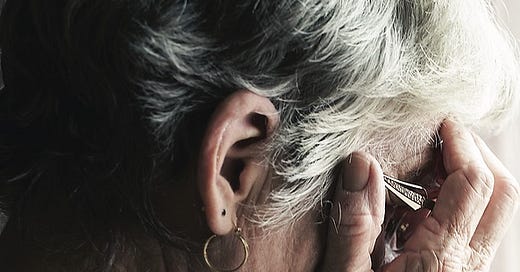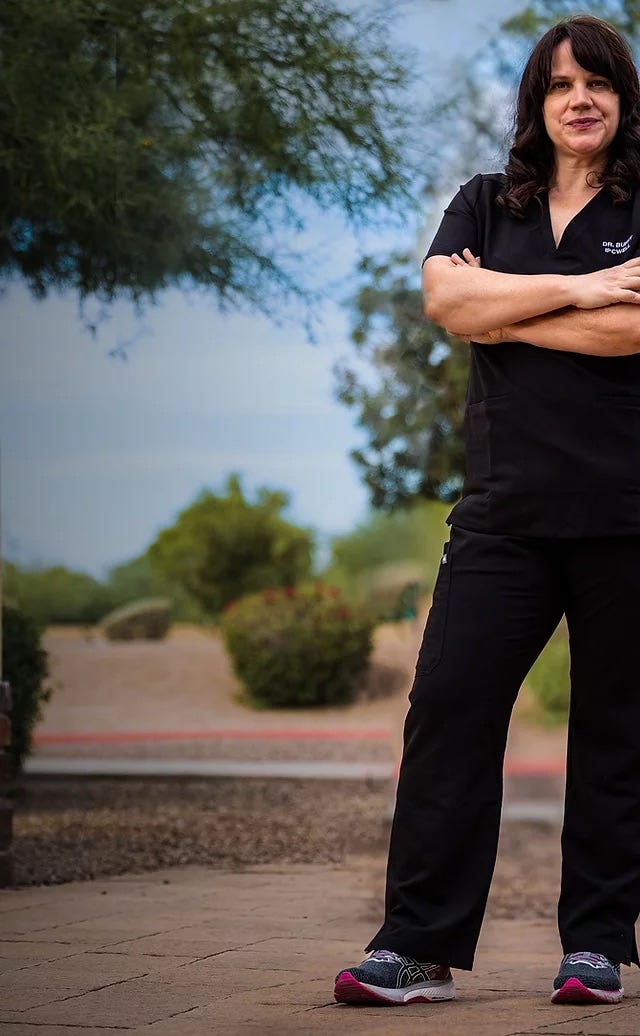“I wrote BROKEN to shine a light on the healthcare heroes in nursing homes, and to demonstrate what they were truly up against in combating this virus”
Dr. Buffy Lloyd-Krejci
In her book entitled BROKEN, infection control expert Dr. Buffy Lloyd-Krejci exposes the need for a massive policy overhaul in terms of infection control practices at the estimated 16,000 nursing homes across the nation. Through interviews with frontline healthcare staff, advocacy organizations, and regulators, Lloyd-Krejci does a deep dive into the flawed nursing home industry amid a pandemic that exposed many critical flaws in prevention practices. As she notes in the book’s introduction:
"My intention in writing this book is to demonstrate solutions that WORK in a system that is broken; with facilities being penalized instead of nurtured. Whether I’m testifying before Congress about what I've seen in more than 700 nursing homes, or working directly with government officials to tackle the biggest problems, assisting Native American and other underserved communities, or travelling the globe with Doctors Without Borders to combat infection in the most vulnerable corners of the earth, I simply cannot stand by when I can be an agent of change"
A little about you and how you became interested in infection control
Lloyd-Krejci: I’ve been working in healthcare for 30 years. I started as a hospital unit coordinator in the medical/surgical unit at a teaching hospital, then worked for a hospital in Hawaii developing a pre-operative clinic. I then found myself working in an intensive care unit/cardiovascular intensive care unit where I had a front row seat at how devastating infectious diseases like Clostridioides difficile infection (CDIFF), Methicillin-resistant staphylococcus aureus (MRSA), pneumonia, and influenza were to a community and human life.
In 2009, I witnessed a 38-year-old pregnant woman die due to the H1N1 flu strain. This woke me up. I furthered my education in Applied Mathematics while conducting Epidemiological research at Arizona State University; I completed my Master’s degree in biomedical informatics at the Mayo Clinic, and then finally my Doctor of Public Health with a specialization in Epidemiology at Capella University.
Where did all of this take you next?
Lloyd-Krejci: Ever since my hospital work, I have been on a mission to understand how infections spread in a community, and most specifically in a healthcare setting. After working on a national pilot study with the Centers for Medicare and Medicaid Services (CMS) and the Centers for Disease Control and Prevention (CDC) supporting over 500 nursing homes nationally enroll and reporting CDIFF infections into the CDC, I learned that there are between 1-3 million serious infections that occur in nursing homes every year. These infections lead to 380,000 deaths—over 1,000 deaths daily. And this was all before the pandemic.
In 2018, called to take a more proactive role to support the nursing homes industry in implementing evidence-based infection prevention and control practices, I left my public health job and started IPCWell.
And then the COVID-19 pandemic hit.
Lloyd-Krejci: Yes. Little did I know that, only 18 short months later, this global pandemic would strike and leave in its wake devastating consequences in the nursing home industry where infection control practices were just barely starting to ramp up. It was only on November 29, 2019 that every skilled nursing facility in the country was required to have a part-time infection preventionist working on-site. In June 2020, I joined the first ever Doctors Without Borders US-based mission as the IP Manger. This mission was dedicated to supporting hard hit nursing homes. The mission continued to Houston, Texas. From that point forward, I was in hundreds of nursing homes across the country assisting with the COVID-19 response.
Can you share with us what you witnessed?
Lloyd-Krejci: No matter where I was, I continued to hear the same stories around how nursing homes were not prepared, didn’t have PPE, and were last on the government’s priority list of support. Instead of offering collaborative help and assistance, CMS sent in state surveyors to determine what the nursing homes were doing wrong. Financial assistance was tied to quality versus need. Fines and citations were handed out. Punishment versus support is what occurred. All at a time when all other CMS state surveys were suspended for all other healthcare settings, such as hospitals. At a time when the nursing homes had very little staff to combat the virus, and virtually no resources such as PPE and COVID-19 tests.
What eventually sparked your decision to write this book?
Lloyd-Krejci: I wrote BROKEN to shine a light on the healthcare heroes in nursing homes, and to demonstrate what they were truly up against in combating this virus. I wrote it to reveal a true story of heroism and courage. Most of all, I wrote this book as a call to action. As a country, we have chosen to place our most vulnerable population (elderly, disabled, and mentally affirmed) in long-term care facilities, yet the funding and support for nursing homes continue to decline. Right now, as I write these words, there is a CMS proposed rule to slash CMS funding to nursing homes by $320 million. This to me is an indicator that things are going in the wrong direction.
Who is the book’s message specifically directed toward?
Lloyd-Krejci: The book has several audiences: First, to all the healthcare staff that work in the nursing homes. It is my prayer that they are truly honored for the work that they do every day. Next, to consumers. If they have a loved one that is in a nursing home, this book can equip them to advocate for change. Finally, to policy makers. Now is the time to support our nursing homes. Not just monetarily, but with ongoing support and collaboration.
What do you believe is the biggest misconception the media and general public continues to harbor about the nursing home industry’s response (or lack of) to COVID?
Lloyd-Krejci: The first nursing home outbreak, ground zero, was in the Life Care Center of Kirkland, a Seattle suburb. The facility had 129 staff and residents’ contract COVID-19, 38 died. The facility called the CDC and requested a strike team to come onsite. Before they got there, CMS (regulators) came onsite and conducted a targeted infection control survey. The nursing home Administrator begged the surveyors to leave as they were short staff with staff either quitting or out due to COVID-19. She even called the Governor’s office. Still, the surveyors continued and ended up fining the facility over $600,000 (eventually overturned in court) in citations claiming they were not in compliance. This was the precedent for the rest of the country.
So public opinion of nursing homes, long-term care, is low. This is no surprise as the only time we hear about nursing homes is on the evening news and usually about some catastrophic event. The perception is that the care is bad, and these facilities are “death traps”.
Do you even hear of a heartwarming story about how dedicated the staff are in caring for this vulnerable population? As a result of this skewed perception, there is a lack of trust and even respect for our nursing home leaders and staff. Now, are there big problems that have and do occur? Yes. Is the care always good? No. However, is punishing the entire industry based on a few bad actors the right thing to do? It seems like it’s the easy path to me, not the right one.
What, if anything, then have we learned from the failed COVID-19 response?
Lloyd-Krejci: As I’ve stated, nursing homes were not prepared and yet they were blamed for having terrible care. As a result we must ask ourselves, ‘how does a nurse caring for 20 patients have the ability to perform high level care?’ This healthcare provider is set up to fail. Instead of pointing fingers and blaming, we should have rallied and provided support. We must change our approach. If we don’t, the industry will continue to experience highly qualified workers leaving the industry.
Why have infectious diseases been such a prevailing issue among nursing homes over the years? And what are industry leaders saying? Healthcare providers? Families?
Lloyd-Krejci: Infectious diseases were prevalent in long-term care prior to the global pandemic. Unfortunately, proactive infection prevention and control practices have not been a high priority for public health or government entities. In 2009, the Office of Disease Prevention and Health Promotion (ODPHP), under the US Department of Health and Human Services, provided a national plan to prevent healthcare associated infections in hospitals. This plan was expanded in 2013 to include other healthcare settings such as outpatient ambulatory surgical centers and dialysis centers.
Unfortunately, long-term care facilities were slated to be worked on in the final (third) stage. This was despite the statistics that came a decade earlier showing the millions of infections occurring every year. In 2016, CMS published new requirements for nursing homes to implement an infection prevention and control program, antibiotic stewardship program, and part-time infection preventionist all by November 28, 2019. Can you see why they were not ready. The nursing homes were in the process of designing and implementing their infection control programs.
What steps are being taken to address this failed trajectory we are on?
Lloyd-Krejci: In my book, I describe industry leader research such as Dr. Nimalie Stone, Dr. Patricia Stone, Dr. Tamara Konetzka, and Dr. Lona Mody. These industry leaders and academic researchers have been testifying before Congress, publishing academic research, and advocating for change for years. It’s here where I believe that providers and leaders are instrumental in creating and developing a strong infection prevention and control culture within their facility. It’s not the job of one or two folks. It’s a culture that must include everyone.
And family member involvement?
Lloyd-Krejci: Family members are often aware of infectious diseases with outbreaks that occur within their facilities. They assume the facility is doing everything they can, but they don’t know what they don’t know and are not often equipped with the knowledge to support and assist the facility in being proactive to prevent infections. I describe in Chapter 13 of the book the importance of family members getting involved.
What sorts of sobering lessons are you hoping nursing home industry leaders and public health officials learned from the COVID pandemic?
Lloyd-Krejci: Infection prevention and control practices were lagging in the nursing home industry long before COVID-19 and public health and policy leaders knew this. This is not a new discovery. We were slowly working on improving this critical component of care; however, it came too late. Now is the time to learn from this tragedy and make drastic changes. The stories in my book describe, from the perspective of the nursing home staff, academic researchers, patients, and even state regulatory workers, what is needed to heal this broken system.
The real tragedy will occur if we don’t make the necessary changes to support our healthcare workers, implement evidence-based infection prevention and control practices, and offer long-term finances (with accountability) to support the prevention of infections, ultimately preventing harms and deaths.
What is your greatest hope in terms of what readers of your book will walk away with?
Every single person is capable of championing change. A family member, friend, healthcare worker, public health, or public policy worker. We have an obligation to know the challenges and barriers to providing the highest level of care to this vulnerable population. This book provides that story and what steps we can take to create change.






